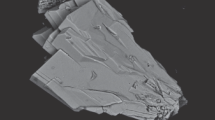Abstract
Crystals of new silicogermanate Pb8K1.68Na0.32[(Ge0.65Si0.35)2O7]3 were synthesized under hydrothermal conditions in the PbO–SiO2–GeO2 system. The new compound is a synthetic variety of the diorthosilicate mineral nasonite Pb6Ca4[Si2O7]3Cl2 related to apatite. The hexagonal unit cell parameters are a = 10.1822(3) Å, c = 13.4088(5) Å, sp. gr. P63/m. The crystal structure was determined by direct methods using the SHELX program package and refined to R = 0.0647 based on 975 reflections with I ≥ 1.96σ(I). The new compound is characterized by wide isomorphism. The Ge and Si atoms occupy a tetrahedral site, and the K and Na atoms share a large-cation site. The main difference between the new compound and nasonite is that all Ca sites in the new compound are occupied by Pb, K, and (K,Na) atoms, and the tetrahedral site is mainly occupied by Ge. In nasonite the channels are filled by Cl anions that compensate the positive charge, whereas these channels are empty in the new synthetic variety. The presence of a large lead cation at the site occupied by Ca in nasonite causes structure distortion and changes in the coordination polyhedra. The umbrella-like coordination of the lead atom at the Pb1 site provides additional space for the lone pair of the Pb atom in the empty channel of the crystal structure; however, the crystals are centrosymmetric and, consequently, exhibit no nonlinear-optical properties.


Similar content being viewed by others
REFERENCES
D. Yu. Pushcharovsky, Structural Mineralogy of Silicates and Their Synthetic Analogs (Nedra, Moscow, 1986) [in Russian].
F. Liebau, Structural Chemistry of Silicates: Structure, Bonding and Classification (Springer, New York, 1985).
Inorganic Crystal Structure Data Base: ICSD (Fachinformationzentrum (FIZ), Karlsruhe, 2011), Version I.
G. Giuseppetti, G. Rossi, and C. Tadini, Am. Mineral. 56, 1174 (1971).
S. Y. Stefanovich, Extended Abstr. Eur. Conf. on Lasers and ElecrtoOptics (CLEO Europe’94), Amsterdam, 1994, p. 249.
Agilent Technologies, CrysAlisPro Software System, Version 1.171.37.35 (Agilent Technologies UK Ltd, Oxford, UK, 2014).
G. M. Sheldrick, Acta Crystallogr. A 64, 112 (2008).
ACKNOWLEDGMENTS
We are grateful to N.V. Zubkova for performing calculations with the CrysAlis program and processing experimental data, including absorption correction. We thank S.Yu. Stefanovich for measuring the second-harmonic generation signal and researchers of the Laboratory of Local Methods of Substance Investigation of the Moscow State University for determining the composition of the crystals.
The study was supported by the Russian Foundation for Basic Research, project no. 17-03-000886a.
Author information
Authors and Affiliations
Corresponding author
Additional information
Translated by T. Safonova
Rights and permissions
About this article
Cite this article
Belokoneva, E.L., Morozov, I.A., Dimitrova, O.V. et al. Pb8K1.68Na0.32[(Ge0.65Si0.35)2O7]3—a Silicogermanate Analogue of the Mineral Nasonite. Crystallogr. Rep. 63, 897–900 (2018). https://doi.org/10.1134/S1063774518060044
Received:
Published:
Issue Date:
DOI: https://doi.org/10.1134/S1063774518060044




